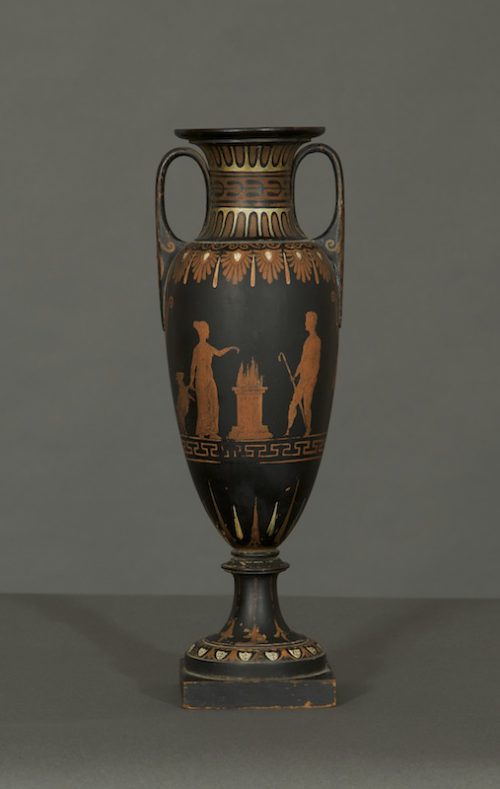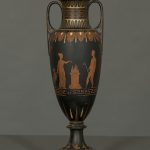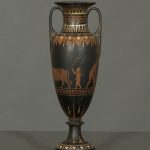11127 A VERY RARE TURNED WOOD AND ETRUSCAN PAINTED AMPHORA-FORM VASE Probably English. Eighteenth Or Early Nineteenth Century. Measurements: Height: 16 3/8″ (42 cm) Diameter: 5 1/2″ (14 cm)

Research
Of black and red painted wood simulating Greek red figure pottery in the form of an amphora, depicting animals and figures performing a sacrifice.
This vase, which is exceedingly rare due to being rendered in the medium of turned wood, would likely have been conceived to take its place in an Etruscan-inspired scheme. The first of these interiors appears to have been the Prospect House tea room at Wimpole Hall, Cambridgeshire, which was decorated by James “Athenian” Stuart circa 1766, while the most complete surviving Etruscan example exists at Osterley Park, Middlesex, designed by Robert Adam circa 1772.
The vase is decorated in the manner of Greek red figure painting, resembling pieces excavated from sites such as Herculaneum, Capua, Bari and Trebbia, and collected by connoisseurs like Sir William Hamilton. The body of the amphora depicts figures performing a sacrifice at a burning altar, with a cow and goat. Anthemions, greek key, and geometric decorations in the same earthy terracotta coloring and white adorn the foot, shoulder and neck of the amphora.
The chief source among contemporary designers for the use of the Etruscan coloration was the publication in four volumes between 1767-1776 of Pierre François d’Hancarville’s Catalogue of the Collection of Etruscan, Greek and Roman antiquities from the cabinet of the Hon. William Hamilton. That work published the red-figure vases acquired by Hamilton whilst British Ambassador at the Court of Naples and given, in 1772, as a gift to the British Museum.
Hamilton’s vases were an important addition to the increasing range and volume of antique sources and gave impetus among the connoisseurs and collectors of the day by helping to promote the theory that the origin and font of all classical civilization lay in Etruscan culture.1 The fact that many of these artifacts were in fact Greek in origin was suspected by Hamilton but did not gain wide acceptance at the time, particularly in Italy where the ancient Etruscan civilization held much nationalist significance.
It is interesting to note that there exists a related pair of turned wood and Etruscan painted vases of nearly-identical large size, from the estate of the renowned English collector Herbert Hall Mulliner (figure 1). The vases were the subject of a lengthy entry in the Bonham’s catalog by whom they were sold on 21 November 2006. The entry was written by scholar Yvonne Jones of Arts and Museums, Wolverhampton.
Footnotes:
1. Hardy, John and Maurice Tomlin, Osterley Park House. London: Victoria and Albert Museum, 1985. 86.



Comments are closed.